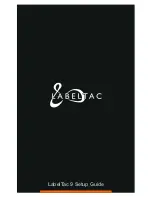
11/14 Rev. 03
USER MANUAL
Advanced Applications
AP 4.4 – AP 5.4 – AP 5.6 – AP 7.t – 64-xx – DPM – PEM – ALX 92x
18
Integration of Ethernet Interface
The Ethernet interface of the printers is layed out as 10/100 Base T. The transmission
speed is set by autonegotiation. LEDs are located above the RJ 45 plug, showing the
network situation [5][6][7].
[5] Position of the signal LEDs at 64-xx, DPM, PEM, ALX 92x (each Gen. 2).
A
LED red lights = Printer is connected to network
B
LED yellow flashes = Network traffic
C
LED green lights = High transmission rate (100 Mbit/s)
[6] Position of the signal LEDs at AP 5.4, AP 7.t, ALX 73x and 64-xx, DPM, PEM, ALX 92x (each Gen. 3)
A
LED yellow lights = Printer is connected to network; LED flashes =Network traffic
B
LED green lights = High transmission rate (100 Mbit/s)
[7] Position of the signal LEDs at AP 5.4 Gen. II and AP 5.6.
A
LED yellow lights = Printer is connected to network; LED flashes =Network traffic
B
LED green lights = High transmission rate (100 Mbit/s)
MAC Address
An internationally unique MAC (Media Access Control) address is required for Ether-
net operation. It consists of 6 bytes and is usually separated by colons or hyphens
(hexadecimal, e.g. 00:0a:44:02:00:49 or 00-0a-44-02-00-49). The first 3 bytes are
constant 00:0A:44 (Avery code), the last 3 bytes vary for each device. The product
manufacturer is responsible for the allocation of the MAC addresses.
IP Address
In the printer software a TCP/IP protocol stack is implemented, i.e. for network purpos-
es the device requires an IP address along with the MAC address. IP-addresses are
always displayed as 4 bytes separated by dots (e.g. 192.168.1.99). IP addresses are
assigned by the network operator, as a rule the network administrator.
MAC and IP addresses originate from different protocol layers and are generally
independent of each other.
Further information about TCP/IP can be found in the abundance of literature on the
subject.
A
B
C
A
B
B
A
















































